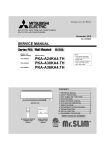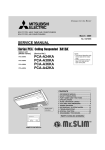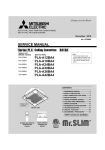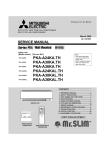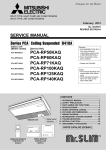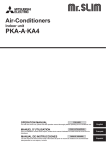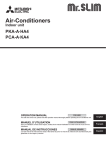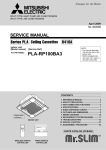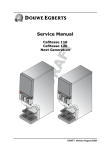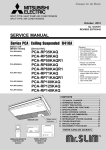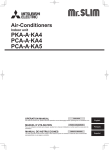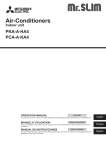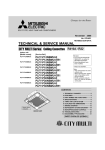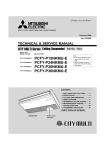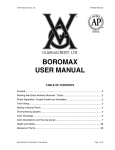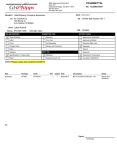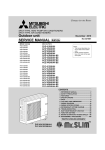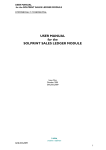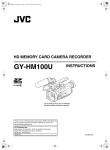Download service manual pca-a24ka4 pca-a30ka4 pca-a36ka4 pca
Transcript
SPLIT-TYPE, HEAT PUMP AIR CONDITIONERS
SPLIT-TYPE, AIR CONDITIONERS
November 2010
No. OCH484
SERVICE MANUAL
Indoor unit
[Model names]
[Service Ref.]
NOTE:
• This manual describes only
service data of the indoor
units.
• RoHS compliant products
have <G> mark on the
spec name plate.
PCA-A24KA4
PCA-A30KA4
PCA-A36KA4
PCA-A42KA4
PCA-A24KA4
PCA-A30KA4
PCA-A36KA4
PCA-A42KA4
CONTENTS
INDOOR UNIT
COOL
DRY
1. REFERENCE MANUAL................................... 2
2. SAFETY PRECAUTION................................... 3
3. PART NAMES AND FUNCTIONS....................4
4. SPECIFICATIONS............................................ 7
5. NOISE CRITERION CURVES.......................... 9
6. OUTLINES AND DIMENSIONS......................10
7. WIRING DIAGRAM.........................................12
8. REFRIGERANT SYSTEM DIAGRAM............ 13
Model name
9. TROUBLESHOOTING................................... 14
indication
10. SPECIAL FUNCTION..................................... 28
11. DISASSEMBLY PROCEDURE.......................31
AUTO
FAN
HEAT
PARTS CATALOG (OCB484)
TEMP.
ON/OFF
WIRED REMOTE
CONTROLLER
(Option)
IR WIRELESS REMOTE
CONTROLLER (Option)
33223
1
REFERENCE MANUAL
OUTDOOR UNIT’S SERVICE MANUAL
Model name
Service Ref.
Service Manual No.
PUZ-A18/24/30/36/42NHA4
PUZ-A18/24/30/36/42NHA4
PUZ-A18/24/30/36/42NHA4-BS
PUZ-A18/24/30/36/42NHA4-BS
PUY-A18/24/30/36/42NHA4
PUY-A18/24/30/36/42NHA4
PUY-A18/24/30/36/42NHA4-BS
PUY-A18/24/30/36/42NHA4-BS
OCH481
OCB481
Remote controller (Optional parts)
Radio frequency interface
Wired remote controller
IR wireless remote controller
COOL
DRY
AUTO
FAN
HEAT
RF thermostat
TEMP.
ON/OFF
2
2
SAFETY PRECAUTION
2-1. ALWAYS OBSERVE FOR SAFETY
Before obtaining access to terminal, all supply
circuits must be disconnected.
2-2. CAUTIONS RELATED TO NEW REFRIGERANT
Cautions for units utilising refrigerant R410A
Use new refrigerant pipes.
Do not use refrigerant other than R410A.
Make sure that the inside and outside of refrigerant piping is clean and it has no contaminants
such as sulfur, oxides, dirt, shaving particles, etc,
which are hazards to refrigerant cycle.
In addition, use pipes with specified thickness.
Contamination inside refrigerant piping can cause deterioration of refrigerant oil etc.
Store the piping to be used indoors during
installation, and keep both ends of the piping
sealed until just before brazing. (Leave elbow
joints, etc. in their packaging.)
If other refrigerant (R22 etc.) is used, chlorine in refrigerant can cause deterioration of refrigerant oil etc.
Use a vacuum pump with a reverse flow check
valve.
Vacuum pump oil may flow back into refrigerant cycle and
that can cause deterioration of refrigerant oil etc.
Use the following tools specifically designed for
use with R410A refrigerant.
The following tools are necessary to use R410A refrigerant.
If dirt, dust or moisture enters into refrigerant cycle, that can
cause deterioration of refrigerant oil or malfunction of compressor.
Gauge manifold
Charge hose
Gas leak detector
Torque wrench
Tools for R410A
Flare tool
Size adjustment gauge
Vacuum pump adaptor
Electronic refrigerant
charging scale
The refrigerant oil applied to flare and flange
connections must be ester oil, ether oil or
alkylbenzene oil in a small amount.
Handle tools with care.
If large amount of mineral oil enters, that can cause deterioration of refrigerant oil etc.
If dirt, dust or moisture enters into refrigerant cycle, that can
cause deterioration of refrigerant oil or malfunction of compressor.
Charge refrigerant from liquid phase of gas
cylinder.
Do not use a charging cylinder.
If the refrigerant is charged from gas phase, composition
change may occur in refrigerant and the efficiency will be
lowered.
If a charging cylinder is used, the composition of refrigerant will change and the efficiency will be lowered.
Ventilate the room if refrigerant leaks during
operation. If refrigerant comes into contact with
a flame, poisonous gases will be released.
[1] Cautions for service
(1) Perform service after recovering the refrigerant left in unit completely.
(2) Do not release refrigerant in the air.
(3) After completing service, charge the cycle with specified amount of refrigerant.
(4) When performing service, install a filter drier simultaneously.
Be sure to use a filter drier for new refrigerant.
3
[2] Additional refrigerant charge
When charging directly from cylinder
· Check that cylinder for R410A on the market is syphon type.
· Charging should be performed with the cylinder of syphon stood vertically. (Refrigerant is charged from liquid phase.)
Unit
Gravimeter
[3] Service tools
Use the below service tools as exclusive tools for R407C refrigerant.
No.
1
Tool name
Specifications
Gauge manifold
· Only for R410A
· Use the existing fitting specifications. (UNF1/2)
· Use high-tension side pressure of 5.3MPa·G or over.
2
Charge hose
· Only for R410A
· Use pressure performance of 5.09MPa·G or over.
3
Electronic scale
4
Gas leak detector
· Use the detector for R134a, R407C or R410A.
5
Adaptor for reverse flow check
· Attach on vacuum pump.
6
Refrigerant charge base
7
Refrigerant cylinder
8
Refrigerant recovery equipment
3
—
—
· Only for R410A
· Top of cylinder (Pink)
· Cylinder with syphon
—
PART NAMES AND FUNCTIONS
Indoor Unit
Louver
Air outlet
Vane
Air intake
4
Filter
(Inside of Air intake)
Wired remote controller (Option)
“Sensor” indication
Display Section
For purposes of this explanation,
all parts of the display are shown
as lit. During actual operation, only
the relevant items will be lit.
Displayed when the remote controller
sensor is used.
Day-of-Week
Shows the current day of the week.
Time/Timer Display
“Locked” indicator
Shows the current time, unless the simple or Auto Off
timer is set.
If the simple or Auto Off timer is set, the time to be
switched off is shown.
Indicates that remote controller buttons have been locked.
Identifies the current operation
“Clean The Filter” indicator
Shows the operating mode, etc.
*Multilanguage display is available.
To be displays on when it is time to
clean the filter.
TIME SUN MON TUE WED THU FRI SAT
TIMER
Hr
ON
AFTER
Indicates that operation from the
remote controller has been prohibited by a master controller.
FUNCTION
FILTER
°F°C
°F°C
“Centrally Controlled” indicator
Timer indicators
AFTER OFF
ERROR CODE
The indicator comes on if the corresponding timer is set.
WEEKLY
SIMPLE
AUTO OFF
ONLY1Hr.
Fan Speed indicator
Shows the selected fan speed.
“Timer is Off” indicator
Indicates that the timer is off.
Up/Down Air Direction indicator
The indicator shows the direction of the outcoming airflow.
“One Hour Only” indicator
Temperature Setting
Shows the target temperature.
Displays if the airflow is set to
Low or downward during COOL
or DRY mode. (Operation varies
according to model.)
The indicator goes off in one hour,
at which time the airflow direction
also changes.
Room Temperature display
Shows the room temperature. The room
temperature display range is 46-102°F.
The display blinks if the temperature
is less than 46°F or 102°F or more.
Ventilation indicator
Appears when the unit is running in
Ventilation mode.
Louver display
Indicates the action of the swing louver.
Does not appear if the louver is not
running.
(Power On indicator)
Indicates that the power is on.
Operation Section
ON/OFF button
Temperature setting buttons
Down
Fan Speed button
Up
Timer Menu button
(Monitor/Set button)
Filter
button
(<Enter> button)
Mode button (Return button)
TEMP.
ON/OFF
Set Time buttons
Check button (Clear button)
Back
Ahead
Timer On/Off button
(Set Day button)
Test Run button
MENU
BACK
PAR-21MAA
MONITOR/SET
ON/OFF
FILTER
DAY
CHECK TEST
OPERATION
CLOCK
Airflow Up/Down button
CLEAR
Louver button
(
Operation button)
To return operation
number
Opening the
cover
Built-in temperature sensor
Ventilation button
( Operation button)
To go to next operation
number
Note:
● “PLEASE WAIT” message
This message is displayed for approximately 3 minutes when power is supplied to the indoor unit or when the unit is recovering from a power failure.
● “NOT AVAILABLE” message
This message is displayed if an invalid button is pressed (to operate a function that the indoor unit does not have).
If a single remote controller is used to operate multiple indoor units simultaneously that are different types, this message will not be displayed as
far as any of the indoor units is equipped with the function.
5
IR wireless remote controller (Option)
CHECK TEST RUN display
Indicate that the unit is being checked or
test-run.
MODEL SELECT display
display
Blinks when model is selected.
Lights up while the signal is transmitted to
the indoor unit when the button is pressed.
Temperature setting display
Indicates the desired temperature setting
which is set.
CLOCK display
OPERATION MODE display
Displays the current time.
OPERATION MODE display
Indicates which operation mode is in effect.
COOL
DRY
AUTO
FAN
HEAT
display
The vertical direction of airflow is indicated.
TIMER display
CHECK TEST
MODEL RUN
SELECT
FAN
°F
°C
STOP AMPM
SWING
“” “
START AMPM
NOT AVAILABLE
ON/OFF
Displays when in timer operation or when
setting timer.
“
TEMP
” display
Displays the order of timer operation.
”“
” display
Displays whether timer is on or off.
display
button
Displays selected fan speed.
Sets any desired room temperature.
ON/OFF button
The unit is turned ON and OFF alternately
each time the button is pressed.
FAN SPEED SELECT button
MODE
FAN
AUTO STOP
VANE
AUTO START
CHECK LOUVER
h
Changes the fan speed.
TEST RUN
min
MODE SELECT button
Switches the operation mode between
COOLING/DRY/FAN/HEATING and AUTO
mode.
SET
RESET
TIMER CONTROL buttons
AUTO STOP (OFF timer): when this switch
is set, the air conditioner will be
automatically stopped at the preset time.
AUTO START (ON timer): when this switch is
set, the air conditioner will be automatically
started at the preset time.
CLOCK
"h" and "min" buttons
+In case the outdoor unit is cooling only
type, the heating and auto mode are not
available.
Buttons used to set the “hour and minute” of
the current time and timer settings.
LOUVER button
CHECK-TEST RUN button
Changes left / right airflow direction.
(Not available for this model.)
Performs an inspection
check or test
operation. Do not use it for normal
operation.
CLOCK button
VANE CONTROL button
RESET button
Changes the air flow direction.
SET button
6
INDOOR UNIT
INDOOR UNIT
INDOOR UNIT
4
SPECIFICATIONS
Service Ref.
Power supply(phase, cycle, voltage)
Max. Fuse Size
Min.Circuit Ampacity
External finish
Heat exchanger
Fan
Fan(drive) % No.
Fan motor output
Fan motor
PCA-A24KA4
1 phase, 60Hz, 208/230V
15
1
White Munsell 6.4Y 8.9/0.4
Plate fin coil
Sirocco fan (direct) % 3
0.095
0.54
Dry: 15-16-17-19(530-565-600-670)
Wet: 14-15-16-18(495-530-565-635)
0(direct blow)
Remote controller & built-in
33-35-37-40
26(1-1/32)
1,280(50-3/8)
680(26-3/4)
230(9-1/16)
32(71)
A
A
kW
F.L.A
Airflow(Low-Medium2-Medium1-High) m3/min(CFM)
External static pressure
Operation control & Thermostat
Noise level(Low-Medium2-Medium1-High)
Field drain pipe O.D.
Dimensions
W
D
H
Weight
Service Ref.
Power supply(phase, cycle, voltage)
Max. Fuse Size
Min.Circuit Ampacity
External finish
Heat exchanger
Fan
Fan(drive) % No.
Fan motor output
Fan motor
Pa(mmAq)
dB
mm(in.)
mm(in.)
mm(in.)
mm(in.)
kg(lbs)
PCA-A30KA4
1 phase, 60Hz, 208/230V
15
1
White Munsell 6.4Y 8.9/0.4
Plate fin coil
Sirocco fan (direct) % 3
0.095
0.54
Dry: 16-17-18-20(565-600-635-705)
Wet:15-16-17-19(530-565-600-670)
0(direct blow)
Remote controller & built-in
35-37-39-41
26(1-1/32)
1,280(50-3/8)
680(26-3/4)
230(9-1/16)
32(71)
A
A
kW
F.L.A
Airflow(Low-Medium2-Medium1-High) */min(CFM)
External static pressure
Operation control & Thermostat
Noise level(Low-Medium2-Medium1-High)
Field drain pipe O.D.
W
Dimensions
D
H
Weight
Service Ref.
Power supply(phase, cycle, voltage)
Max. Fuse Size
Min.Circuit Ampacity
External finish
Heat exchanger
Fan
Fan(drive) % No.
Fan motor output
Fan motor
Pa(mmAq)
dB
mm(in.)
mm(in.)
mm(in.)
mm(in.)
kg(lbs)
PCA-A36KA4
1 phase, 60Hz, 208/230V
15
2
White Munsell 6.4Y 8.9/0.4
Plate fin coil
Sirocco fan (direct) % 4
0.160
0.97
Dry: 22-24-26-28(775-850-920-990)
Wet:20-22-24-26(705-775-850-920)
0(direct blow)
Remote controller & built-in
37-39-41-43
26(1-1/32)
1,600(63)
680(26-3/4)
230(9-1/16)
36(79)
A
A
kW
F.L.A
Airflow(Low-Medium2-Medium1-High) */min(CFM)
External static pressure
Operation control & Thermostat
Noise level(Low-Medium2-Medium1-High)
Field drain pipe O.D.
W
Dimensions
D
H
Weight
Pa(mmAq)
dB
mm(in.)
mm(in.)
mm(in.)
mm(in.)
kg(lbs)
7
INDOOR UNIT
Service Ref.
Power supply(phase, cycle, voltage)
Max. Fuse Size
Min.Circuit Ampacity
External finish
Heat exchanger
Fan
Fan(drive) % No.
Fan motor output
Fan motor
PCA-A42KA4
1 phase, 60Hz, 208/230V
15
2
White Munsell 6.4Y 8.9/0.4
Plate fin coil
Sirocco fan (direct) % 4
0.160
0.97
Dry: 23-25-27-29(810-885-955-1025)
Wet: 21-23-25-27(740-810-885-955)
0(direct blow)
Remote controller & built-in
39-41-43-45
26(1-1/32)
1,600(63)
680(26-3/4)
230(9-1/16)
38(84)
A
A
kW
F.L.A
Airflow(Low-Medium2-Medium1-High) */min(CFM)
External static pressure
Operation control & Thermostat
Noise level(Low-Medium2-Medium1-High)
Field drain pipe O.D.
Dimensions
W
D
H
Weight
Pa(mmAq)
dB
mm(in.)
mm(in.)
mm(in.)
mm(in.)
kg(lbs)
8
5
NOISE CRITERION CURVES
NOTCH SPL(dB)
High
40
Medium1
37
Medium2
35
Low
33
PCA-A30KA4
LINE
90
90
80
80
70
OCTAVE BAND SOUND PRESSURE LEVEL, dB (0 dB = 0.0002 μbar)
OCTAVE BAND SOUND PRESSURE LEVEL, dB (0 dB = 0.0002 μbar)
PCA-A24KA4
NC-70
60
NC-60
50
NC-50
40
NC-40
30
NC-30
20
APPROXIMATE
THRESHOLD OF
HEARING FOR
CONTINUOUS
NOISE
63
70
250
500
1000
2000
4000
50
NC-50
40
NC-40
30
NC-30
10
8000
NC-70
NC-60
20
125
APPROXIMATE
THRESHOLD OF
HEARING FOR
CONTINUOUS
NOISE
63
NC-20
125
250
NOTCH SPL(dB)
High
43
Medium1
41
Medium2
39
Low
37
90
80
80
70
NC-70
60
NC-60
50
NC-50
40
NC-40
30
NC-30
10
APPROXIMATE
THRESHOLD OF
HEARING FOR
CONTINUOUS
NOISE
63
125
1000
2000
8000
4000
NC-60
50
NC-50
40
NC-40
30
NC-30
10
8000
APPROXIMATE
THRESHOLD OF
HEARING FOR
CONTINUOUS
NOISE
63
125
NC-20
250
500
1000
2000
BAND CENTER FREQUENCIES, Hz
ceiling
3.3ft
unit
about 4.62ft
MICROPHONE
9
LINE
NC-70
BAND CENTER FREQUENCIES, Hz
3.3ft
4000
60
20
500
2000
70
NC-20
250
1000
NOTCH SPL(dB)
High
45
Medium1
43
Medium2
41
Low
39
PCA-A42KA4
OCTAVE BAND SOUND PRESSURE LEVEL, dB (0 dB = 0.0002 μbar)
OCTAVE BAND SOUND PRESSURE LEVEL, dB (0 dB = 0.0002 μbar)
LINE
90
20
500
BAND CENTER FREQUENCIES, Hz
BAND CENTER FREQUENCIES, Hz
PCA-A36KA4
LINE
60
NC-20
10
NOTCH SPL(dB)
High
41
Medium1
39
Medium2
37
Low
35
4000
8000
7-1/2(190)
1-13/16(46)
1
2
3
4
5
6
7
8
3(76)
4-7/8(124)
8
120°
7
15-1/4(387)
1-1/2(38)
11/16(18)
10-1/4(260)
1-7/8(48)
9-11/16(246)
9-3/16(233)
Drainage
When drain socket
is installed
1/16(1)
Air intake
5-7/16(138)
1/16(2)
3-3/8(86)
3-3/8(85)
4
Drainage pipe connection(1(26mm)I.D.)
Drainage pipe connection(for the left arrangement)
Knockout hole for left drain-piping arrangement
Refrigerant-pipe connection(gas pipe side/flared connection)
Refrigerant-pipe connection(liquid pipe side/flared connection)
Knockout hole for upper drain pipe arrangement
Knockout hole for fresh air intake Φ3-15/16(Φ100)
Knockout hole for wiring arrangement Φ7/8(Φ22)
Accessory...Drain socket (1(26mm) I.D.)
2
18-1/8(461)
Ceiling
4-3/4(121)
In case of the rear pipe arrangement, make sure to
remove the shaded portions from the independent piece.
Then put the independent piece back in initial
position.(The heat exchanger might be clogged because of dust)
5/16(8)
When electrical box
is pulled down
2
Electrical box
2-15/16(75)
3
12
5)
Φ4
-15
/16
(Φ
4-15/16(126)
1-7/16(37)
Electrical box
7-1/12(190)
1/16(2)
Air outlet
47-3/16(1198)
46-3/16(1173)
50-3/8(1280)
48-11/16(1237) (Suspension bolt pitch)
5-7/8(150)
1
7-3/16(182)
5-1/2(140)
2-7/16(62)
1/16(2)
3-1/8(80)
3-3/8(85)
3-7/16(88)
5
26-3/4(680)
7-11/16(195)
[FRONT VIEW]
12-5/8(320)
3-5/16(84)
10(254)
10
2-1/4(57)
6
2(51)
9/16
14
When drain socket
is installed
Drainage
9-3/16(233)
DEFROST/STAND BY lamp
Receiver
Operation lamp
Emergency operation
switch <Heating>
liquid Φ3/8(Φ9.52)
gas Φ5/8(Φ15.88)
9-11/16(246)
7-7/8(200)
NOTES.
1.Use M10 or W3/8 screw for anchor bolt.
2.Please be sure when installing the drain pump (option parts),
refrigerant pipe will be only upward.
i-see sensor
Emergency operation
switch <Cooling>
9-5/16(236)
7-1/16(180)
In case of wireless remote controller
and i-see sensor(Optional Parts)
In case of wireless
remote controller
and i-see sensor
(Optional Parts)
3/16(5)
3/8(10)
PCA-A30KA4
26-3/4(680)
PCA-A24KA4
18-3/4(476)
6
OUTLINES AND DIMENTIONS
Unit: inch (mm)
9-1/16(230)
11/16(18)
2
3
18-1/8(461)
4-3/4(121)
7-1/2(190)
1-13/16(46)
3(76)
4-7/8(124)
8
120°
7
15-1/4(387)
1-1/2(38)
11/16(18)
10-1/4(260)
3-3/8(85)
5-7/16(138)
1/16(2)
3-3/8(86)
6
7
8
5
1
2
3
4
1-7/8(48)
9-11/16(246)
9-3/16(233)
1/16(1)
Drainage
When drain socket
is installed
Electrical box
1/16(2)
7-1/2(190)
Drainage pipe connection(1(26mm)I.D.)
Drainage pipe connection(for the left arrangement)
Knockout hole for left drain-piping arrangement
Refrigerant-pipe connection
(gas pipe side/flared connection)
Refrigerant-pipe connection
(liquid pipe side/flared connection)
Knockout hole for upper drain pipe arrangement
Knockout hole for fresh air intake Φ3-15/16(Φ100)
Knockout hole for wiring arrangement Φ7/8(Φ22)
Accessory...Drain socket (1(26mm)I.D.)
2
5/16(8)
Air outlet
59-3/4(1518)
58-3/4(1493)
63(1600)
61-5/16(1557) (Suspension bolt pitch)
11/16(18)
5-7/8(150)
4
In case of the rear pipe arrangement, make sure to
remove the shaded portions from the independent piece.
Then put the independent piece back in initial
position.(The heat exchanger might be clogged because of dust)
When electrical box
is pulled down
2-15/16(75)
Ceiling
12
5)
Φ4
-15
/16
(Φ
4-15/16(126)
1-7/16(37)
Electrical box
5
7-3/16
182
5-1/2
140
62
2-7/16
6
1/16(2)
3-3/8
85
3-5/16(84)
Air intake
10(254)
NOTES.
1.Use M10 or W3/8 screw for anchor bolt.
2.Please be sure when installing the drain pump (option parts),
refrigerant pipe will be only upward.
12-5/8(320)
3-7/16(88)
18-3/4(476)
1
3-1/8
80
26-3/4(680)
7-11/16(195)
[FRONT VIEW]
2(51)
9/16
14
liquid Φ3/8(Φ9.52)
gas Φ5/8(Φ15.88)
When drain socket
is installed
Drainage
9-3/16(233)
9-11/16(246)
7-7/8(200)
7-1/16(180)
9-5/16(236)
Emergency operation
switch <Heating>
DEFROST/STAND BY lamp
Receiver
Operation lamp
Emergency operation
switch <Cooling>
In case of wireless remote controller
and i-see sensor(Optional Parts)
In case of wireless
remote controller
and i-see sensor
(Optional Parts)
3/16(5)
3/8(10)
9-1/16(230)
11
2-1/4
57
PCA-A42KA4
26-3/4(680)
PCA-A36KA4
Unit: inch (mm)
7
WIRING DIAGRAM
PCA-A24KA4
PCA-A30KA4
PCA-A36KA4
PCA-A42KA4
[LEGEND]
SYMBOL
I.B
CN2L
CN24
CN30
CN32
CN41
CN51
CN105
FUSE
LED1
LED2
LED3
SW1
SW2
SWE
X1
MF
MV
RFI
NAME
INDOOR CONTROLLER BOARD
CONNECTOR (LOSSNAY)
CONNECTOR (BACK-UP HEATING)
CONNECTOR (LLC)
CONNECTOR (REMOTE SWITCH)
CONNECTOR (HA TERMINAL-A)
CONNECTOR (CENTRALLY CONTROL)
CONNECTOR (RADIO FREQUENCY INTERFACE)
FUSE (T6.3AL250V)
POWER SUPPLY (I.B)
POWER SUPPLY (R.B)
TRANSMISSION (INDOOR-OUTDOOR)
SWITCH (MODEL SELECTION) +See table 1
SWITCH (CAPACITY CODE) +See table 2
CONNECTOR (EMERGENCY OPERATION)
RELAY (DRAIN PUMP)
FAN MOTOR
VANE MOTOR
RADIO FREQUENCY INTERFACE FOR RF THERMOSTAT
<Table 2> SW2 (CAPACITY CODE)
SW2
MODELS
Service
MODELS
1 2 3 4 5
PCA-A24KA4
1 2 3 4 5
PCA-A30KA4
SYMBOL
TB4
TB5,TB6
TH1
TH2
TH5
OPTIONAL PARTS
W.B
BZ
LED1
LED2
RU
SW1
SW2
DP
FS
R.B
TB6
1 2 3 4 5
ON PCA-A42KA4
OFF
Refer to tables 1 and 2
ON
OFF
ON
OFF
I.B
SW1
20 18 16 14 12 10 8 6 4 2
SW2
J41 J42
CN32
(WHT) 1
Pair No.
CN51 (WHT)
19 17 15 13 11 9 7 5 3 1
5
CN2L
LED3
LED2
LED1
2 1
1
9
CNB
BZ
M
SW1
LED2
MV
SW2
LED1
RU
W.B
4
4
9
5
1
I-SEE
SENSOR
1
5
6
YLW
ORN
3
RFI
CN01
(BLK)
1 3
2 1
1 2
INDOOR/OUTDOOR
COMMUNICATION
CN3C
(BLU)
ORN
BRN
DC294~325V
RECTIFICATION
FUSE
ON OFF
CN105
(RED)
1
5
FLOAT SW
CN4F
(WHT)
1
When attaching
drain pump
(optional parts),
remove the
jumper
connector
CN4F and fit
the drain float
switch (FS).
LIQUID/PIPE INTAKE
CN44
CN20 CN30
(WHT)
(RED) (GRN)
4
4
1 2
t°
t°
TH2 TH5
t°
TH1
1
When attaching
drain pump
(optional parts)
FLOAT SW
CN4F
(WHT)
1
TB4
YLW S1
ORN S2
S3
REMOCON
CN22
(BLU)
1
5
M
MT
I-SEE SENSOR
(OPTIONAL PARTS)
2
CN24
(YLW)
CN41 (WHT)
4
ON
OFF
OUTDOOR 1 3 5
1
SWE
(RED)
I-SEE
SENSOR MOTOR
CN6Y
(RED)
1 2 3 4 5
TRANSMISSION
WIRES
DC12V
2 1
TB6
R.B
VANE CNV (WHT)
<Table 1> SW1 (MODEL SELECTION)
SW1
Service
TB5
2
1
The black square (■) indicates a switch position.
WIRELESS
CN90
(WHT)
PCB FOR IR WIRELESS REMOTE CONTROLLER
BUZZER
LED (OPERATION INDICATION : GREEN)
LED (PREPARATION FOR HEATING : ORANGE)
RECEIVING UNIT
EMERGENCY OPERATION (HEAT / DOWN)
EMERGENCY OPERATION (COOL / UP)
DRAIN PUMP
DRAIN FLOAT SWITCH
WIRED REMOTE CONTROLLER BOARD
TERMINAL BLOCK (REMOTE CONTROLLER
TRANSMISSION LINE)
Service
1 2 3 4 5
ON PCA-A36KA4
OFF
I-SEE
SENSOR
CN4Y
(WHT)
NAME
TERMINAL BLOCK (INDOOR/OUTDOOR CONNECTING LINE)
TERMINAL BLOCK (REMOTE CONTROLLER
TRANSMISSION LINE)
ROOM TEMP. THERMISTOR
(32°F / 15kΩ, 77°F / 5.4kΩ DETECT)
PIPE TEMP. THERMISTOR/LIQUID
(32°F / 15kΩ, 77°F / 5.4kΩ DETECT)
COND. / EVA. TEMP. THERMISTOR
(32°F / 15kΩ, 77°F / 5.4kΩ DETECT)
1
3
X1
7
FAN
CNMF
(WHT)
4
MS
1
1 D.U.M
3
CNP
(BLU)
M
3~
1~
MF
DP
(OPTIONAL PARTS)
+Be sure to turn off the source power
4
and then disconnect fan motor connector.
(Failure to do so will cause trouble in Fan motor)
FS
Notes: 1. SymboIs used in wiring diagram above are,
: Connector,
:Terminal block.
2. Indoor and outdoor connecting wires are made with poIarities, make wiring matching terminal numbers (S1, S2, S3).
3. Since the outdoor side electric wiring may change, be sure to check the outdoor unit electric wiring for servicing.
+ 1 : Use copper supply wire.
12
+1
TO OUTDOOR
UNIT
8
REFRIGERANT SYSTEM DIAGRAM
PCA-A24KA4
PCA-A30KA4
PCA-A36KA4
PCA-A42KA4
Strainer
#50
Heat exchanger
Refrigerant GAS pipe connection
(Flare)
Condenser/evaporator
temperature thermistor
(TH5)
Refrigerant flow in cooling
Refrigerant flow in heating
Refrigerant LIQUID pipe connection
(Flare)
Room temperature
thermistor (TH1)
Pipe temperature
thermistor/liquid
(TH2)
Distributor
with strainer 1/2
#50/#50
Strainer
#50
13
9
TROUBLESHOOTING
9-1. TROUBLESHOOTING
<Error code display by self-diagnosis and actions to be taken for service (summary)>
Present and past error codes are logged and displayed on the wired remote controller or controller board of outdoor unit.
Actions to be taken for service and the trouble reoccurrence at field are summarized in the table below. Check the contents
below before investigating details.
Unit conditions at service
Error code
Actions to be taken for service (summary)
Displayed
Judge what is wrong and take a corrective action
according to “9-3. Self-diagnosis action table”.
The trouble is reoccurring.
Not displayed
Logged
The trouble is not reoccurring.
Not logged
Conduct troubleshooting and ascertain the cause of the
trouble according to “9-4. Troubleshooting by inferior
phenomena”.
Consider the temporary defects such as the work of
protection devices in the refrigerant circuit including
compressor, poor connection of wiring, noise and etc.
Re-check the symptom, and check the installation
environment, refrigerant amount, weather when the
trouble occurred, matters related to wiring and etc.
Reset error code logs and restart the unit after finishing
service.
There is no abnormality in electrical component,
controller board,remote controller and etc.
Re-check the abnormal symptom.
Conduct trouble shooting and ascertain the cause of the
trouble according to “9-4. Troubleshooting by inferior
phenomena”.
Continue to operate unit for the time being if the cause
is not ascertained.
There is no abnormality concerning of parts such as
electrical component, controller board, remote controller
and etc.
14
9-2. MALFUNCTION-DIAGNOSIS METHOD BY REMOTE CONTROLLER
<In case of trouble during operation>
When a malfunction occurs to air conditioner, both indoor unit and outdoor unit will stop and operation lamp blinks to inform
unusual stop.
<Malfunction-diagnosis method at maintenance service>
■IR wireless remote controller
[Procedure]
Refrigerant
address
display
CHECK
CHECK
display
Temperature
button
TEMP
ON/OFF
1. Press the CHECK button twice.
• "CHECK" lights, and refrigerant
address "00" blinks.
• Check that the remote controller's
display has stopped before continuing.
2. Press the temperature
buttons.
• Select the refrigerant address of the
indoor unit for the self-diagnosis.
Note: Set refrigerant address using the
outdoor unit’s DIP switch (SW1).
(For more information, see the
outdoor unit installation manual.)
ON/OFF
button
MODE
FAN
AUTO STOP
VANE
AUTO START
CHECK LOUVER
CHECK
button
h
3. Point the remote controller at the • If an air conditioner error occurs, the
sensor on the indoor unit and
indoor unit's sensor emits an intermitpress the HOUR button.
tent buzzer sound, the operation lamp
blinks, and the error code is output.
(It takes 3 seconds at most for error
code to appear.)
HOUR
button
min
TEST RUN
RESET
SET
CLOCK
4. Point the remote controller at the • The check mode is cancelled.
sensor on the indoor unit and
press the ON/OFF button.
■Wired remote controller
Turn on the power.
Press the [CHECK] button twice.
Set address with [TEMP] button if system control is used.
Press the [ON/OFF] button to stop the self-check.
CHECK button
Address
TEMP. button
IC : Indoor unit
OC: Outdoor unit
– – – – : No trouble generated in the past.
Check code
F F F F : No corresponding unit.
Unit No.
ERROR CODE
ERROR CODE
TEMP.
ON/OFF
MENU
BACK
PAR-21MAA
MONITOR/SET
ON/OFF
FILTER
DAY
CHECK TEST
OPERATION
CLOCK
ERROR CODE
Timer ON/OFF button
CLEAR
<To delete check code>
Display the error code on the self-check result display screen.
The address for self-check will blink when the ON/OFF
button is pressed twice within 3 seconds.
To be continued to the next page.
15
• Refer to the following tables for details on the check codes.
[Output pattern A]
Beeper sounds
OPERATION
INDICATOR
lamp blink
pattern
Beep
Beep Beep Beep
Off
Beep
1st
2 nd
3 rd
nth
On
On
On
On
Beep Beep
1st
Off
On
2 nd · · · Repeated
On
0.5 sec. Approx. 2.5 sec. 0.5 sec. 0.5 sec.
Self-check Approx. 2.5 sec. 0.5 sec. 0.5 sec. 0.5 sec.
starts
(Start signal
Number of blinks/beeps in pattern indicates the check
Number of blinks/beeps in pattern indicates
received)
code in the following table (i.e., n=5 for “P5”)
the check code in the following table
[Output pattern B]
Beeper sounds
OPERATION
INDICATOR
lamp blink
pattern
Beep
Beep Beep Beep
1st
Off
On
Approx. 3 sec.
Self-check Approx. 2.5 sec.
starts
(Start signal
received)
2nd
Beep
Beep
nth
1st
3 rd
On
On
On
0.5 sec. 0.5 sec. 0.5 sec.
On
Off
0.5 sec. Approx. 2.5 sec.
Number of blinks/beeps in pattern indicates the check
code in the following table (i.e., n=5 for “U2”)
On
Approx. 3 sec.
Beep
2 nd · · · Repeated
On
On
0.5 sec. 0.5 sec.
Number of blinks/beeps in pattern indicates
the check code in the following table
[Output pattern A] Errors detected by indoor unit
IR wireless remote controller Wired remote controller
Beeper sounds/OPERATION
Check code
INDICATOR lamp blinks
(Number of times)
1
P1
P2
2
P9
3
E6,E7
4
P4
P5
5
PA
6
P6
7
EE
8
P8
9
E4, E5
–
10
–
11
12
Fb
E0, E3
–
–
E1, E2
Symptom
Remark
Intake sensor error
Pipe (TH2) sensor error
Pipe (TH5) sensor error
Indoor/outdoor unit communication error
Float switch connector (CN4F) open
Drain pump error
Forced compressor stop(due to water leakage abnormality)
Freezing/Overheating protection operation
Communication error between indoor and outdoor units
Pipe temperature error
Remote controller signal receiving error
–
–
Indoor unit control system error (memory error, etc.)
Remote controller transmission error
Remote controller control board error
[Output pattern B] Errors detected by unit other than indoor unit (outdoor unit, etc.)
IR wireless remote controller Wired remote controller
Beeper sounds/OPERATION
INDICATOR lamp blinks
Check code
(Number of times)
1
E9
2
3
4
UP
U3,U4
UF
5
U2
6
U1,Ud
7
8
9
10
U5
U8
U6
U7
11
U9,UH
Symptom
Indoor/outdoor unit communication error
(Transmitting error) (Outdoor unit)
Compressor overcurrent interruption
Open/short of outdoor unit thermistors
Compressor overcurrent interruption (When compressor locked)
Abnormal high discharging temperature/49C operated/
insufficient refrigerant
Abnormal high pressure (63H operated)/Overheating
protection operation
Abnormal temperature of heatsink
Outdoor unit fan protection stop
Compressor overcurrent interruption/Abnormal of power module
Abnormality of superheat due to low discharge temperature
Abnormality such as overvoltage or voltage shortage and
abnormal synchronous signal to main circuit/Current sensor error
–
–
Other errors (Refer to the technical manual for the outdoor unit.)
Remark
For details, check
the LED display
of the outdoor
controller board.
As for outdoor
unit, refer to
outdoor unit's
service manual.
–
12
–
13
Others
14
*1 If the beeper does not sound again after the initial 2 beeps to confirm the self-check start signal was received and
the OPERATION INDICATOR lamp does not come on, there are no error records.
*2 If the beeper sounds 3 times continuously “beep, beep, beep (0.4 + 0.4 + 0.4 sec.)” after the initial 2 beeps to confirm
the self-check start signal was received, the specified refrigerant address is incorrect.
16
• On IR wireless remote controller
The continuous buzzer sounds from receiving section of indoor unit.
Blink of operation lamp
• On wired remote controller
Check code displayed in the LCD. (Refer to the previous page,
check code.)
• If the unit cannot be operated properly after the test run, refer to the following table to find out the cause.
Symptom
Cause
Wired remote controller
LED 1, 2 (PCB in outdoor unit)
For about 2
After LED 1, 2 are lighted, LED 2 is •For about 2 minutes following power-on,opPLEASE WAIT
minutes after
turned off, then only LED 1 is
eration of the remote controller is not possible
lighted. (Correct operation)
power-on
due to system start-up. (Correct operation)
•Connector for the outdoor unit’s protection
Only LED 1 is lighted.
device is not connected.
PLEASE WAIT
Error code
LED 1, 2 blink. •Reverse or open phase wiring for the outdoor
Subsequent to
unit’s power terminal block (L1, L2, GR)
about 2 minutes
after power-on Only LED 1 is lighted.
Display messages do not
•Incorrect wiring between indoor and outdoor
appear even when operation
LED 1 blinks twice, units (incorrect polarity of S1, S2, S3)
switch is turned ON (operation
LED 2 blinks once. •Remote controller wire short
lamp does not light up).
On the IR wireless remote controller with condition above, following phenomena take place.
• No signals from the remote controller can be received.
• OPE lamp is blinking.
• The buzzer makes a short ping sound.
Note:
Operation is not possible for about 30 seconds after cancellation of function selection. (Correct operation)
For description of each LED (LED1, 2, 3) provided on the indoor controller, refer to the following table.
LED1 (power for microprocessor)
LED2 (power for wired remote controller)
Indicates whether control power is supplied. Make sure that this LED is
always lit.
Indicates whether power is supplied to the wired remote controller.
This LED lights only in the case of the indoor unit which is connected to the
outdoor unit refrigerant addresses “0”.
LED3 (communication between indoor and
outdoor units)
Indicates state of communication between the indoor and outdoor units.
Make sure that this LED is always blinking.
17
9-3. SELF-DIAGNOSIS ACTION TABLE
Error Code
P1
Abnormal point and detection method
Room temperature thermistor (TH1)
The unit is in 3-minute resume
prevention mode if short/open of
thermistor is detected. Abnormal if the
unit does not reset normally after 3 minutes. (The unit returns to normal operation, if it has been reset normally.)
Constantly detected during cooling,
drying, and heating operation.
Short: 90
Open: -40
Note: Refer to the manual of outdoor unit for the details of display
such as F, U, and other E.
Countermeasure
Cause
Defective thermistor
– Check resistance value of thermistor.
• • • • • • • • • • 15.0k
characteristics
0
• • • • • • • • • • • • 9.6k
10
Contact failure of connector
• • • • • • • • • • • • 6.3k
(CN20) on the indoor controller
20
• • • • • • • • • • • • 4.3k
board (Insert failure)
30
• • • • • • • • • • •3.0k
40
Breaking of wire or contact
failure of thermistor wiring
If you put force on (draw or bend) the lead wire
while measuring resistance value of thermisDefective indoor controller
board
tor, breaking of wire or contact failure can be
detected.
Check contact failure of connector (CN20) on
the indoor controller board. Refer to 9-7.
Turn the power on again and check restart
after inserting connector again.
Check room temperature display on remote
controller.
Replace indoor controller board if there is
abnormal difference with actual room
temperature.
Turn the power off, and on again to operate
after check.
P2
Pipe temperature thermistor/Liquid
(TH2)
The unit is in 3-minute resume
prevention mode if short/open of
thermistor is detected. Abnormal if the
unit does not reset normally after 3 minutes. (The unit returns to normal operation, if it has been reset normally.)
Constantly detected during cooling,
drying, and heating (except defrosting)
operation.
Short: 90
Open: -40
Defective thermistor
– Check resistance value of thermistor.
characteristics
For characteristics, refer to (P1) above.
Contact failure of connector
Check contact failure of connector (CN44) on
(CN44) on the indoor controller
the indoor controller board. Refer to 9-7.
board (Insert failure)
Turn the power on and check restart after
Breaking of wire or contact
inserting connector again.
failure of thermistor wiring
Check pipe <liquid> temperature with remote
Defective refrigerant circuit is
controller in test run mode. If pipe <liquid>
causing thermistor temperatemperature is extremely low (in cooling
ture of 90
mode) or high (in heating mode), refrigerant
-40
circuit may have defect.
Defective indoor controller
Check pipe <liquid> temperature with remote
board
controller in test run mode. If there is extremely
difference with actual pipe <liquid> temperature,
replace indoor controller board.
Turn the power off, and on again to operate
after check.
P4
(5701)
P5
Contact failure of drain float switch (CN4F)
Extract when the connector of drain float
switch is disconnected.
( and of connector CN4F is not
short-circuited.)
Constantly detected during operation.
Contact failure of connector
(Insert failure)
Drain overflow protection operation
Suspensive abnormality, if drain float
switch is detected to be underwater for
1 minute and 30 seconds continuously
with drain pump on.
Turn off compressor and indoor fan.
Drain pump is abnormal if the condition
above is detected during suspensive
abnormality.
Constantly detected during drain pump
operation.
Malfunction of drain pump
Defective drain
Clogged drain pump
Clogged drain pipe
Defective drain float switch
Catch of drain float switch or
malfunction of moving parts
cause drain float switch to be
detected under water (Switch
On)
Defective indoor-controller
board
Defective indoor controller
board
Check contact failure of float switch connector.
Turn the power on again and check after
inserting connector again.
Operate with connector (CN4F) short-circuited.
Replace indoor controller board if abnormality
reappears.
Check if drain pump operates.
Check drain function.
Remove drain float switch connector CN4F
and check if it is short (Switch On) with the
moving part of float switch UP, or OPEN with
the moving part of float switch down.
Replace float switch if it is short with the
moving part of float switch down.
Replace indoor controller board if it is shortcircuited between - of the drain float
switch connector CN4F and abnormality
reappears.
It is not abnormal if there is no problem about
the above-mentioned ~
Turn the power off, and on again to operate
after check.
18
Error Code
P6
Abnormal point and detection method
Countermeasure
Cause
Freezing/overheating protection is
(Cooling or drying mode)
(Cooling or drying mode)
opearting
Clogged filter (reduced airflow)
Check clogs of the filter.
Freezing protection (Cooling mode)
Short cycle of air path
Remove blockage.
The unit is in 6-minute resume prevention
Low load (low temperature)
mode if pipe <liquid or condenser/evapooperation out of the tolerance
rator> temperature stays under
range
Refer to 9-6.
Defective indoor fan motor
the compressor started. Abnormal if it
• Fan motor is defective.
• Indoor controller board is defecagain within 16 minutes after 6-minute
tive.
resume prevention mode.
Defective outdoor fan control
Check outdoor fan motor.
Overcharge of refrigerant
Check operating condition of refrigerant
circuit.
Defective refrigerant circuit
(clogs)
Overheating protection (Heating mode)
The units is in 6-minute resume
prevention mode if pipe <liquid or
condenser/evaporator> temperature is
detected as over 70°C[158°F] after the
compressor started. Abnormal if the
temperature of over 70°C[158°F] is
detected again within 10 minutes after
6 minute resume prevention mode.
Pipe temperature
<Cooling mode>
Detected as abnormal when the pipe temperature is not in the cooling range 3 minutes after compressor start and 6 minutes
after the liquid or condenser/evaporator pipe
is out of cooling range.
Note 1) It takes at least 9 minutes to detect.
Note 2) Abnormality P8 is not detected in
drying mode.
Cooling range : (TH-TH1)
TH: Lower temperature between liquid pipe
temperature (TH2) and condenser/
evaporator temperature (TH5)
TH1: Intake temperature
P8
<Heating mode>
When 10 seconds have passed after the
compressor starts operation and the hot
adjustment mode has finished, the unit is
detected as abnormal when condenser/
evaporator pipe temperature is not in heating range within 20 minutes.
Note 3) It takes at least 27 minutes to
detect abnormality.
Note 4) It excludes the period of defrosting
(Detection restarts when defrosting
mode is over)
Heating range :
(TH5-TH1)
(Heating mode)
(Heating mode)
Check clogs of the filter.
Clogged filter (reduced airflow)
Remove blockage.
Short cycle of air path
Overload (high temperature)
operation out of the tolerance
range
Refer to 9-6.
Defective indoor fan motor
• Fan motor is defective.
• Indoor controller board is defective.
Defective outdoor fan control
Check outdoor fan motor.
Overcharge of refrigerant
~ Check operating condition of refrigerant
circuit.
Defective refrigerant circuit
(clogs)
Bypass circuit of outdoor unit
is defective.
Slight temperature difference
between indoor room
temperature and pipe <liquid
or condenser/evaporator>
temperature thermistor
• Shortage of refrigerant
• Disconnected holder of pipe
<liquid or condenser/
evaporator> thermistor
• Defective refrigerant circuit
Converse connection of
extension pipe (on plural units
connection)
Converse wiring of indoor/
outdoor unit connecting wire
(on plural units connection)
Defective detection of indoor
room temperature and pipe
<condenser/evaporator>
temperature thermistor
Stop valve is not opened
completely.
19
~
(
Check pipe <liquid or condenser/evaporator> temperature with room temperature display on remote controller and
outdoor controller circuit board.
Pipe <liquid or condenser/evaporator>
temperature display is indicated by setting SW2 of outdoor controller circuit
board as follows.
Conduct temperature check with outdoor
controller circuit board after connecting
‘A-Control Service Tool (PAC-SK52ST)’.
)
Check converse connection of extension
pipe or converse wiring of indoor/outdoor
unit connecting wire.
Error Code
Abnormal point and detection method
Pipe temperature thermistor/
Condenser-Evaporator (TH5)
The unit is in 3-minute resume protection mode if short/open of thermistor is
detected. Abnormal if the unit does not
get back to normal within 3 minutes. (The
unit returns to normal operation, if it has
been reset normally.)
Constantly detected during cooling,
drying, and heating operation (except
defrosting)
P9
Cause
Defective thermistor
characteristics
Contact failure of connector
(CN44) on the indoor controller
board (Insert failure)
Breaking of wire or contact
failure of thermistor wiring
Temperature of thermistor is
Countermeasure
–
defective refrigerant circuit.
Defective indoor controller
board
(
PA
(2500)
E0
or
E4
Check resistance value of thermistor.
For characteristics, refer to (P1) above.
Check contact failure of connector (CN44) on
the indoor controller board. Refer to 9-7.
Turn the power on and check restart after
inserting connector again.
Operate in test run mode and check pipe <condenser/evaporator> temperature with outdoor
controller circuit board. If pipe
<condenser/evaporator> temperature is exclusively low (in cooling mode) or high (in heating
mode), refrigerant circuit may have defect.
Operate in test run mode and check pipe <condenser/evaporator> temperature with outdoor
control circuit board. If there is
extreme difference with actual pipe
<condenser/evaporator> temperature, replace
indoor controller board.
There is no abnormality if none of above comes
within the unit.
Turn the power off and on again to operate.
In case of checking pipe temperature
with outdoor controller circuit board,
be sure to connect A-control service
tool (PAC-SK52ST).
)
Forced compressor stop
(due to water leakage abnormality)
The unit has a water leakage abnormality when the following conditions, a)
and b), are satisfied while the abovementioned detection is performed.
a) The intake temperature subtracted
with liquid pipe temperature detects to
be less than -10 [14
30 minutes. (When the drain sensor
is detected to be NOT soaked in the
water, the detection record of a) and b)
will be cleared.)
b) Drain float switch detects to be in the
water for more than 15 minutes.
*Once the water leakage abnormality is
detected, abnormality state will not be
released until the main power is reset.
Drain pump trouble
Drain defective
· Drain pump clogging
· Drain pipe clogging
Open circuit of float switch
Contact failure of float switch
connector
Dew condensation on float switch
·Drain water descends along
lead wire.
·Drain water waving due to filter
clogging.
Extension piping connection
difference at twin, triple, quadruple system.
Miswiring of indoor/outdoor
connecting at twin, triple, quadruple system.
Room temperature thermistor/
liquid pipe temperature thermistor detection is defective.
Remote controller transmission
error(E0)/signal receiving error(E4)
Abnormal if main or sub remote controller cannot receive any transmission
normally from indoor unit of refrigerant
address “0” for 3 minutes.
(Error code : E0)
Abnormal if sub remote controller could
not receive for any signal for 2 minutes.
(Error code: E0)
Contact failure at transmission
Check disconnection or looseness of indoor
wire of remote controller
unit or transmission wire of remote controller.
All remote controllers are set
Set one of the remote controllers “main”
as “sub” remote controller. In
if there is no problem with the action above.
this case, E0 is displayed on
Check wiring of remote controller.
remote controller, and E4 is
displayed at LED (LED1, LED2)
(Do not use cable 3 or more.)
on the outdoor controller circuit
• The number of connecting indoor units:
board.
max. 16 units
Miswiring of remote controller
• The number of connecting remote controlDefective transmitting receiving
ler: max. 2 units
circuit of remote controller
When the above-mentioned problem of ~
Defective transmitting receiving are not applied,
circuit of indoor controller board
Diagnose remote controllers.
of refrigerant addresses “0”.
a) When “RC OK” is displayed, remote conNoise has entered into the
trollers have no problem. Turn the power
transmission wire of remote
off, and on again to check. If abnormality
controller.
generates again, replace indoor controller
board.
b) When “RC NG” is displayed, replace
remote controller.
c) When “RC E3” or “ERC 00-06” is displayed, noise may be causing abnormality.
Abnormal if indoor controller board
cannot receive any data normally from
remote controller board or from other
indoor controller board for 3 minutes.
(Error code: E4)
Indoor controller board cannot receive
any signal from remote controller for 2
minutes. (Error code: E4)
Check the drain pump.
Check whether water can be drained.
Check the resistance of the float switch.
Check the connector contact failure.
Check the float switch leadwire mounted.
Check the filter clogging.
Check the piping connection.
Check the indoor/outdoor connecting wires.
Check the room temperature display of
remote controller.
Check the indoor liquid pipe temperature display of outdoor controller board.
If the unit is not normal after replacing
indoor controller board in group control,
indoor controller board of address “0”
may be abnormal.
20
Error Code
E3
or
E5
E6
E7
Fb
E1
or
E2
Abnormal point and detection method
Remote controller transmission
error(E3)/signal receiving error(E5)
Abnormal if remote controller could not
find blank of transmission path for 6 seconds and could not transmit.
(Error code: E3)
Remote controller receives transmitted
data at the same time, compares the
data, and when detecting it, judges
different data to be abnormal 30
continuous times. (Error code: E3)
Abnormal if indoor controller board could
not find blank of transmission path.
(Error code: E5)
Indoor controller board receives transmitted data at the same time, compares
the data,and when detecting it, judges
different data to be abnormal 30
continuous times. (Error code: E5)
Countermeasure
Cause
2 remote controllers are set as
“main.”
(In case of 2 remote controllers)
Remote controller is connected
with 2 indoor units or more.
Repetition of refrigerant
address
Defective transmitting receiving
circuit of remote controller
Defective transmitting receiving
circuit of indoor controller board
Noise has entered into transmission wire of remote controller.
Set a remote controller to main, and the
other to sub.
Remote controller is connected with only one
indoor unit.
The address changes to a separate setting.
~ Diagnose remote controller.
a) When “RC OK” is displayed, remote controllers have no problem.
Turn the power off, and on again to check.
When becoming abnormal again, replace
indoor controller board.
b) When “RC NG” is displayed, replace
remote controller.
c) When “RC E3” or “ERC 00-66” is displayed, noise may be causing abnormality.
Indoor/outdoor unit communication
error (Signal receiving error)
Abnormal if indoor controller board
cannot receive any signal normally for 6
minutes after turning the power on.
Abnormal if indoor controller board
cannot receive any signal normally for 3
minutes.
Consider the unit as abnormal under
the following condition: When 2 or more
indoor units are connected to an
outdoor unit, indoor controller board
cannot receive a signal for 3 minutes
from outdoor controller circuit board, a
signal which allows outdoor controller
circuit board to transmit signals.
Contact failure, short circuit or,
miswiring (converse wiring) of
indoor/outdoor unit connecting
wire
Defective transmitting receiving
circuit of outdoor controller
circuit board
Defective transmitting receiving
circuit of indoor controller board
Noise has entered into indoor/
outdoor unit connecting wire.
Check LED display on the outdoor control
circuit board. (Connect A-control service
tool, PAC-SK52ST.)
Refer to EA-EC item if LED displays EA-EC.
Check disconnection or looseness of indoor/
outdoor unit connecting wire of indoor unit or
outdoor unit.
Check all the units in case of twin indoor
unit system.
- Turn the power off, and on again to check.
If abnormality generates again, replace
indoor controller board or outdoor
controller circuit board.
Other indoor controller board may have
defect in case of twin indoor unit system.
Indoor/outdoor unit communication
error (Transmitting error)
Abnormal if indoor controller board
receives “1” 30 times continuously when
indoor controller board transmits “0” signal.
Defective transmitting receiving
circuit of indoor controller board
Noise has entered into power
supply.
Noise has entered into outdoor
control wire.
-
Indoor controller board
Abnormal if data cannot be read normally
from the nonvolatile memory of the indoor
controller board.
Defective indoor controller
board
Replace indoor controller board.
Remote controller control board
Abnormal if data cannot be read normally from the nonvolatile memory of the
remote controller control board.
(Error code: E1)
Defective remote controller
Replace remote controller.
Abnormal if the clock function of remote
controller cannot be operated normally.
(Error code: E2)
21
Turn the power off, and on again to check.
If abnormality generates again, replace
indoor controller board.
9-4. TROUBLESHOOTING BY INFERIOR PHENOMENA
Note: Refer to the manual of outdoor unit for the detail of remote
controller.
Phenomena
(1)Upward/downward vane
performance failure
Cause
Countermeasure
The vane is not downward during defrosting and heat
preparation and when the thermostat is OFF in HEAT
mode. (Working of COOL protection function)
Vane motor does not rotate.
• Defective vane motor
• Breaking of wire or connection failure of connector
Upward/downward vane does not work.
• The vane is set to fixed position.
(2)Receiver for IR wireless remote
controller
Weak batteries of IR wireless remote controller
Contact failure of connector (CNB) on IR wireless
remote controller board
(Insert failure)
Contact failure of connector (CN90) on indoor controller board (Insert failure)
Contact failure of connector between IR wireless
remote controller board and indoor controller board
22
Normal operation (The vane is set to
horizontal regardless of remote control.)
Check (left).
• Check the vane motor. (Refer to “How
to check the parts”.)
• Check for breaking of wire or connection failure of connector.
Normal operation (Each connector on
vane motor side is disconnected or setting the fixed vanes by wired remote
controller.)
Replace batteries of IR wireless remote
controller.
~
Check contact failure of each connector.
If no problems are found of connector,
replace indoor controller board.
When the same trouble occurs even if
indoor controller board is replaced,
replace IR wireless remote controller
board.
9-5. EMERGENCY OPERATION
9-5-1. When IR wireless remote controller fails or its battery is exhausted
When the remote controller cannot be used
When the batteries of the remote controller run out or the remote controller malfunctions, the emergency operation can be done using the emergency buttons on the grille.
DEFROST/STAND BY lamp
Operation lamp
Emergency operation switch (heating)
Emergency operation switch (cooling)
Receiver
Starting operation
for more than 2
button
• To operate the cooling mode, press the
seconds.
for more than 2
• To operate the heating mode, press the
button
seconds.
* Lighting of the Operation lamp means the start of operation.
Note:
• Details of emergency mode are as shown below.
Operation mode
Set temperature
Fan speed
Airflow direction
Stopping operation
• To stop operation, press the
COOL
24°C, 75°F
High
Horizontal
button
HEAT
24°C, 75°F
High
Downward 5
or the
button
.
9-5-2. When wired remote controller or indoor unit microprocessor fails
1.When the wired remote control or the indoor unit microprocessor has failed, but all other components work properly,
if you set the switch (SWE) on the indoor controller board ON, the indoor unit will begin emergency operation.
When emergency operation is activated, the indoor unit operates as follows:
(1)Indoor fan is running at high speed. (2)Drain pump is working. (option)
+ Note on the IR wireless remote control: when the remote control does not function, it is possible to activate
emergency operation by using the indoor unit emergency operation switch (SW1, SW2 of the IR wireless signal
receiver board).
However, if the indoor unit microprocessor has failed, it is necessary to proceed with points (2) and (3) below as in
the case of the wired remote controller.
2.When you activate emergency operation of the cooling or heating, you have to set the switch (SWE) on the indoor
controller board and activate emergency operation of the outdoor unit.
For details on how to activate emergency operation of the outdoor unit, refer to the outdoor unit wiring diagram.
3.Before you activate emergency operation, check the following points:
(1)Emergency operation cannot be activated when:
• the outdoor unit malfunctions. • the indoor fan malfunctions.
• when it has detected the malfunction of drain pump during self-diagnosing.
(2)Emergency operation becomes continuous only by switching the power source on/off.
ON/OFF on the remote control or temperature control etc. does not function.
(3)Avoid operating for a long time when the outdoor unit begins defrosting while emergency operation
of the heating is activated because it will start to blow cold air.
(4)Emergency cooling should be limited to 10 hours maximum (The indoor unit heat exchanger may freeze).
(5)After emergency operation has been deactivated, set the switches etc. to their original positions.
(6)Movement of the vanes does not work in emergency operation, therefore you have to slowly set them
manually to the appropriate position.
23
9-6. HOW TO CHECK THE PARTS
PCA-A24KA4 PCA-A30KA4
PCA-A36KA4
Parts name
PCA-A42KA4
Check points
Room temperature
thermistor
(TH1)
Liquid pipe thermistor
(TH2)
Condenser/evaporator
temperature thermistor
(TH5)
Disconnect the connector then measure the resistance with a tester.
(At the ambient temperature 50"F~86"F)
Vane motor (MV)
Measure the resistance between the terminals with a tester.
(At the ambient temperature of 68°F~86°F)
White
Orange
Red
Yellow
Blue
Drain pump (DP) (Option)
YLW
1
3
YLW
Drain float switch (FS)
(Option)
Normal
Abnormal
4.3k~9.6k
Open or short
Connector
Red - Yellow
Red - Blue
Red - Orange
Red - White
(Refer to the next page for a detail.)
Normal
Abnormal
300
Open or short
Measure the resistance between the terminals with a tester.
(Winding temperature 68°F)
Normal
290
Abnormal
Open or short
Measure the resistance between the terminals with a tester.
State of moving part
Normal
Abnormal
1
UP
Short
Other than short
2
DOWN
Open
Other than open
Moving part
Switch
Magnet
3
Moving
Part
4
i-see sensor
(Option)
Turn on the indoor unit with the black plastic tape on the outside of i-see sensor controller board.
i-see sensor rotates then pull out the connector of motor for i-see sensor.
With electricity being turned on, measure the power voltage between connectors with tester.
Black plastic tape
4
3
2 1
i-see sensor (At the ambient temperature of 50°F~104°F)
4 3
2
i-see sensor connector
1
Blue BlackPink Brown
(–)—(+)
Normal
DC 1.857V~ 3.132V
Abnormal
Other than the normal
(+)—(–)
DC 0.939V~ 1.506V
Other than the normal
NOTE : Be careful not to discharge static electricity into electronic device.
Vane motor for
i-see sensor (Option)
White
Orange
Red
Blue
Yellow
Measure the resistance between the terminals with a tester.
(At the ambient temperature of 68°F~86°F)
Connector
Red - Yellow
Red - Blue
Red - Orange
Red - White
Normal
Abnormal
250
Open or short
24
9-6-1. Thermistor
<Thermistor Characteristic graph>
Thermistor for
lower temperature
<Thermistor for lower temperature>
50
Room temperature thermistor (TH1)
Pipe temperature thermistor/liquid (TH2)
Condenser/evaporator temperature
thermistor (TH5)
1
t( )Rt=15exp { 3480(
273+t
Resistance (k )
Thermistor R0=15k ± 3%
Fixed number of B=3480 ± 2%
1
)}
273
1
273+ T-32
1.8
40
1
273
0
10
20
25
30
40
30
20
10
0
-20 -10 0 10 20 30 40 50 °C
-4 -14 32 50 68 86 104122 °F
Temperature
9-6-2. DC Fan motor (fan motor/indoor controller circuit board)
Check method of DC fan motor (fan motor/indoor controller circuit board)
Notes
· High voltage is applied to the connecter (CNMF) for the fan motor. Pay attention to the service.
· Do not pull out the connector (CNMF) for the motor with the power supply on.
(It causes trouble of the indoor controller circuit board and fan motor.)
Self check
Symptom : The indoor fan cannot turn around.
Wiring contact check
Contact of fan motor connector (CNMF)
Is there contact failure?
Yes
Wiring recovery
No
Power supply check (Remove the connector (CNMF))
Measure the voltage in the indoor controller circuit board.
TEST POINT : VDC (between 1 (+) and 4 (-) of the fan connector): VDC DC294~325V
TEST POINT : VCC (between 5 (+) and 4 (-) of the fan connector): VCC DC15V
Is the voltage normal?
No
Yes
Replace the fan motor
OK
Check the operation
Replace indoor controller board.
NG
Replace indoor controller board.
OK
Check the operation
END
NG
Replace the fan motor.
25
END
9-7. TEST POINT DIAGRAM
Indoor controller board
PCA-A24KA4
PCA-A30KA4
CN90
Connect to the IR wireless
remote controller board (CNB)
PCA-A36KA4
LED3
Transmission
(Indoor/outdoor)
PCA-A42KA4
CN2L
Connector (LOSSNAY)
CN4Y
i-see sensor (option)
CNV
Vane motor output (MV)
12V pulse output
CN6Y
sensor motor (option)
SW1
Model selection
SW2
Capacity setting
CN105
RFI
(Radio frequency interface)
Jumper wire J41,J42
Pair No. setting for IR wireless
remote controller
LED2
Power supply (R.B)
SWE
Emergency operation
CN51
Centrally control
- : Control signal
13VDC pulse input (
: +)
- : Operation indicator
13VDC (: +)
- : Malfunction indicator
13VDC (: +)
CN4F
Drain float switch (FS)
(option)
CN44
Pipe temperature
thermistor
- : Liquid (TH2)
- : Cond./Eva. (TH5)
CN20
Room temperature
thermistor (TH1)
CN41
Connector (HA terminal-A)
LED1
Power supply (I.B)
CN30
Connector (LLC)
CN24
Connector (Back-up heating)
CN22
Connect to the terminal block (TB5)
(Remote controller connecting wire)
(10.4~14.6V DC)
CN3C
Transmission (Indoor/outdoor)
(0~24V DC)
CNMF
Fan motor
-: DC 294~325V
-: DC15V
VCC : Voltage between pins of
C955 15VDC
(Same as (+)–(-) of CNMF)
CN01
Connect to the Terminal Block
(TB4)
(Indoor/outdoor connecting line)
Between and 208/230V AC
CNP
Drain-pump output (DP)
(208/230V AC) (option)
FUSE
6.3A /250V
26
9-8. FUNCTIONS OF DIP SWITCH AND JUMPER WIRE
Each function is controlled by the dip switch and the jumper wire on control P.C. board.
SW1 and SW2 are equipped only for service parts.
Model setting and capacity setting are memorized in the nonvolatile memory of the control P.C. board of
the unit.
The black square (■) indicates a switch position.
Jumper wire (
Jumper wire
Functions
Setting by the dip switch and jumper wire
: Short
: Open)
Remarks
For service board
SW1
Model
settings
1
2
3
4
ON
OFF
MODELS
PCA-A24KA4
PCA-A30KA4
SW2
Capacity
settings
PCA-A36KA4
PCA-A42KA4
J41
J42
Pair number
setting with
IR wireless
remote
controller
JP1
Unit type
setting
JP3
Indoor
controller
board type
setting
5
Service board
1 2 3 4 5
1 2 3 4 5
1 2 3 4 5
1 2 3 4 5
ON
OFF
ON
OFF
ON
OFF
ON
OFF
Wireless remote Control PCB setting
controller setting
J41
J42
0
1
2
3~9
Model
Without TH5
With TH5
There is no jumper (JP1) because these models
have the cond./eva. temperature thermistor (TH5).
JP1
Indoor controller board type
For product
Spare parts
<Initial setting>
IR wireless remote controller: 0
Control PCB: (for both J41 and J42)
Four pair number settings are supported.
The pair number settings of the wireless remote
controller and indoor control PCB (J41/J42) are
given in the table on the left.
(' ' in the table indicates the jumper line is disconnected.)
JP3
27
10
SPECIAL FUNCTION
10-1. Rotation Function (and back-up function, 2nd stage cut-in function)
This function is only available when using wired remote controller.
10-1-1. Operation
(1) Rotation function (and Back-up function)
Outline of functions
· Main and sub units operate alternately according to the interval of rotation setting.
w Main and sub unit should be set by refrigerant address. (Outdoor Dip switch setting)
Refrigerant address "00"
Main unit
Refrigerant address "01"
Sub unit
· When error occurs to one unit, another unit will start operation. (Back-up function)
System constraint
· This function is available only by the grouping control system (INDOOR UNIT: OUTDOOR UNIT=1:1) of 2 refrigerant
groups. (Refer to Fig. 1)
· Main indoor unit should be connected for wired remote controller and the transmission line (TB5) for main and sub unit
should also be connected. (Refer to Fig. 1)
(This function cannot be set by IR wireless remote controller.)
· Set refrigerant address of each unit. (Dip switch on the outdoor unit ··· Refrigerant address 00/01)
Fig. 1
Operation pattern
[Back-up function only]··· Request code number "312"
Error occurs on main unit.
Main
Sub
Start operation
Main
unit
IC-1
Sub
unit
IC-2
Refrigerant address
"00"
Run
Abnormal condition
Stop
Run
3(2)
[Rotation function] & [Back-up function]··· Request code number "313~318"
Start operation
Sub
unit
IC-2
3(2)
Main
Sub
Sub
Error occurs on main unit.
Main Main
Sub
Abnormal condition
Run
Stop
Run
Stop
Run
Stop
1~28 days
Sub
unit
IC-2
IC-1
2
Main
unit
IC-1
OC-2
OC-1
Main
unit
Refrigerant address
"01"
2
RC
OC : Outdoor unit
IC : Indoor unit
RC : Wired remote controller
Run
1~28 days
(Ex:When the request code number is "313", each unit operates alternately in daily cycle.)
Note:
· When the unit is restarted to operate after turning off the power or OFF operation, the unit which was operating will start operation.
· To operate the main unit, refer to the 10-1-2. and set the request code No. which is not the same as the current one, and set
again the former request code No.
(2) 2nd stage cut-in function
Outline of functions
· When the 1st unit can NOT supply with sufficient capacity for exceptionally high-demand conditions and the actual room
temperature reaches set point *, the 2nd unit starts operation in conjunction with the 1st unit.
· Once the actual room temperature goes down to 4 degrees C (7.5 degrees F) below set point*, the 2nd unit stops operation
automatically.
(* set point = set temperature by R/C (remote controller) + 4, 6, 8:(7.5, 10.8, 14.4°F) (selectable))
· Number of operating units is determined according to the room temperature and set point.
· When room temperature becomes higher than set point, standby unit starts. (2 units operation)
· When room temperature falls below set point -4:(-7.5°F), standby unit stops. (1 unit operation)
28
System constraint
· This function is available only in cooling mode.
Ex.) Set temp. by R/C = 20:(68°F)
Set point = 26:(79°F)
When request code number is “323”.
[2nd stage cut-in function]··· Request code number "322~324"
Start operation
26:
(79°F)
22:
(71.5°F)
2nd unit Cut-in
4 degree C
(7.5 degreeF)
2nd unit Cut-out
Main
unit
IC-1
Room temp. Set point
Sub unit start operation
Run
Sub
unit
IC-2
Stop
Run
20:
(68°F)
10-1-2. How to set rotation function (Back-up function, 2nd stage cut-in function)
You can set these functions by wired remote controller.(Maintenance monitor)
NOTE
Both main and sub unit should be set in same setting.
Every time replacing indoor controller board for servicing, the function should be set again.
(1) Request Code List
Rotation setting
Setting No.
(Request code)
No.1
(310)
No.2
(311)
No.3
(312)
No.4
(313)
No.5
(314)
No.6
(315)
No.7
(316)
No.8
(317)
No.9
(318)
Initial
setting
Setting contents
Monitoring the request code of current setting.
Rotation and Back-up OFF (Normal group control operation)
Back-up function only
Rotation ON (Alternating interval = 1day) and back up function
Rotation ON (Alternating interval = 3day) and back up function
Rotation ON (Alternating interval = 5day) and back up function
Rotation ON (Alternating interval = 7day) and back up function
Rotation ON (Alternating interval = 14day) and back up function
Rotation ON (Alternating interval = 28day) and back up function
2nd stage cut-in setting
Setting No.
(Request code)
No.1
(320)
No.2
(321)
No.3
(322)
No.4
(323)
No.5
(324)
Room temp. < Set point -4(-7.5°F)
Sub unit stop
Initial
setting
Setting contents
Monitoring the request code of current setting.
Cut-in function OFF
Cut-in Function ON(Set point = Set temp.+ 4°C(7.5°F))
Cut-in Function ON(Set point = Set temp.+ 6°C(10.8°F))
Cut-in Function ON(Set point = Set temp.+ 8°C(14.4°F))
29
Stop
(2) Setting method of each function by wired remote controller
B: Refrigerant address
C: Data display area
D: Request code display area
1. Stop operation(
).
2. Press the TEST button () for 3 seconds so that [Maintenance mode] appears on the screen ().
After a while, [00] appears in the refrigerant address number display area.(at )
3. Press the CHECK button () for 3 seconds to switch to [Maintenance monitor].
Note) It is not possible to switch to [Maintenance monitor] during data request in maintenance mode
(i.e., while “----” is blinking) since no buttons are operative.
[----] appears on the screen () when [Maintenance monitor] is activated.
(The display () now allows you to set a request code No.)
4. Press the [TEMP (
[ScreenB]
and
5. Press the [CLOCK (
)] buttons () to select the desired refrigerant address.
and
)] buttons () to set the desired request code No.(“311~318”, “321~324”)
6. Press the FILTER button () to perform function setting.
If above setting operations are done correctly, "Request code number" will appear in data display area.()
[Example: When the "311" of "Request code number" is set, [311] appears on the screen.()]
[Refererence]
You can check current "request code number" setting by setting the "request code number"(“310” or “320”) and
pressing the FILTER button.()
[Example: When the current setting is "Setting No.2(Request code 311)", [311] appears on the screen.()]
7. To return to normal mode, press the ON/OFF button (
).
10-2. BACK-UP HEATING FUNCTION (CN24)
Temperature difference
(Z=Set temp. - Room temp.)
10-2-1. Operation
Outline of functions
The back-up heater signal is sent out according to the temperature difference between indoor room temperature and set temperature. This function is available only in heating operation.
Back-up heater
signal output
1
Z 0˚C(˚F)
OFF
2
0 < Z < 2.5˚C(4.5˚F)
Keeping condition
3
2.5˚C(4.5˚F) Z
ON
ON
10-2-2. How to connect
When connecting to the connector CN24 of the indoor unit, use
PAC-SE56RA-E(optional parts).
Z
30
0
2.5˚C(4.5˚F)
OFF
11
DISASSEMBLY PROCEDURE
PCA-A24KA4
PCA-A36KA4
PCA-A30KA4
PCA-A42KA4
Be careful when removing heavy parts.
(Photo: PCA-A36KA4)
OPERATING PROCEDURE
PHOTOS & ILLUSTRATIONS
1. Removing the air intake grille
(1) Slide the air intake grille holding knobs (at 2 or 3 locations) to the rear to open the air intake grille. (See Figure 1)
(2) While the air intake grille left open, push the stoppers
on the rear hinges (at 2 or 3 locations) to pull out the air
intake grille. (See Figure 2)
Figure 1
Figure 2
Air intake grille
slide
Air intake grille
holding knobs
hinges
Pull out the air intake grille
2. Removing the indoor controller board and the electrical box
(1) Remove the air intake grille. (See Figure 1,2)
(2) Remove the beam by removing 1 screw (4 × 8 PT) (See
Photo 1)
(3) Remove 2 screws from the electrical cover, and remove
the electrical cover.
(4) Remove 2 screws from the electrical box and pull the
electrical box downward.
Temporarily secure the electrical box using 2 hooks in
the back of electrical box.
(5) Disconnect the connectors on the indoor controller
board.
[Removing the electrical box]
(6) Disconnect the wires from the terminal blocks and pull
out the electrical box. (See Photo 2)
Photo 1
Electrical cover
Beam fixing screw
(4 × 8 PT)
Beam
Electrical cover
fixing screws (4 × 8 ST)
Photo 2
[Removing the indoor controller board]
(6) Remove the 6 supports from the indoor controller board
and remove the indoor controller board. (See Photo 3)
Electrical box
Electrical box fixing screws
Photo 3
Room temperature
thermistor (TH21)
Indoor controller
board (I.B.)
Terminal blocks
(TB4) (TB5)
31
OPERATING PROCEDURE
3. Removing the room temperature thermistor (TH1)
(1) Remove the air intake grille. (See Figure 1,2)
(2) Remove the beam by removing 1 screw (4 × 8 PT) (See
Photo 1)
(3) Remove 2 screws from the electrical cover, and remove
the electrical cover.
(4) Remove 2 screws from the electrical box and pull the
electrical box downward.
Temporarily secure the electrical box using 2 hooks in
the back of electrical box.
(5) Disconnect the connector CN20 (red) from the indoor
controller board.
(6) Remove the sensor holder from the electrical box and
remove the thermistor from the holder.
4. Removing the fan motor and right side fan
(1) Remove the air intake grille. (See Figure 1,2)
(2) Remove the beam by removing 1 screw (4 × 8 PT) (See
Photo 1)
(3) Remove 2 screws from the electrical cover, and remove
the electrical cover.
(4) Remove 2 screws from the electrical box and pull the
electrical box downward.
(5) Temporarily secure the electrical box using 2 hooks in
the back of electrical box.
(6) Remove the lower casing while pressing the 4 catches of
the casing (right side of the fan motor). (See Photo 6)
(7) Loosen the 2 set screws (2 hexagon set screws) of connecting joint and slide the fan motor to the left. (See
Photo 5)
(8) Remove the screw for motor earth wire. (See Photo 5)
(9) Remove the motor piece (left and right, each 1 screw).
(See Photo 5)
(10) Remove the fan motor and right side fan together.
(11) Loosen the set screw (hexagon set screw) of fan and
remove the fan from the shaft. (See Photo 7,8)
PHOTOS & ILLUSTRATIONS
Photo 4
Casing
Room temperature
thermistor (TH1)
Electrical box
Photo 5
Motor piece
fixing screws
Motor earth wire
fixing screw
Fan motor
Connecting
joint
Casing
Set screws
Electrical box
Casing
Photo 6
Casing
Catches
Catch
Photo 8
Catches
Photo 7
Hexagon set screw
32
Hole for driver
OPERATING PROCEDURE
PHOTOS & ILLUSTRATIONS
5. Removing the fan (3 connection)
(1) Remove the air intake grille. (See Figure 1,2)
(2) Remove the beam by removing 1 screw (4 × 8 PT) (See
Photo 1)
(3) Remove 2 screws from the electrical cover, and remove
the electrical cover.
(4) Remove 2 screws from the electrical box and pull the
electrical box downward.
Temporarily secure the electrical box using 2 hooks in
the back of electrical box.
(5) Remove 2 screws from the left side beam and remove
the beam. (See Photo 9)
(6) Loosen 2 set screws (2 hexagon set screws) of connecting joint. (See Photo 5)
(7) Remove 3 lower casings while pressing each 4 catches
of the casing. (See Photo 6)
(8) Remove the 4 screws from the bearing support. (See
Photo 10)
(9) Slide the connecting joint to the left and remove the fans
and shaft together. (See Photo 11)
(10) Remove the fans from the shaft. (See Photo 7,8 )
Photo 9
Beam
Photo 10
Bearing support
Photo 11
Bearing support
Shaft
Bearing support fixing
screws
Fans (3 connection)
Shaft
6. Removing the side panel
(1) Remove the air intake grille. (See Figure 1,2)
(2) Remove the screws from the side panel, and remove
the side panel by sliding the panel to the front.
(3) Unhook the side panel support hanger, and then slide
the side panel forward to remove it.
Figure 3
Side panel
(Right)
Sliding the panel
to the front
Side panel
(Left)
Screws
Figure 4
Hole for side panel
support hanger
33
Side panel
support hanger
OPERATING PROCEDURE
PHOTOS & ILLUSTRATIONS
Photo 12
7. Removing the vane motor
(1) Remove the air intake. (See Figure 1,2)
(2) Remove the right side panel. (See Figure 3)
(3) Remove the connector of vane motor.
(4) Remove 2 screws of vane motor cover, then remove
vane motor.
Vane motor and cover
Connector
Screws
8. Removing the under panel
(1) Remove the air intake grille. (See Figure 1,2)
(2) Remove the left and right side panels. (See Figure 3)
(3) Remove the beam. (See Photo 1)
(4) Remove the electrical cover. (See Photo 1)
(5) Pull the electrical box downward. (See Photo 2)
(6) (Wireless remote controller receiver type only)
Disconnect the connector CNB from the PCB for wireless remote controller and remove the clamp and strap
for wires.
(7) Remove 8 screws from the under panel.
(8) Move the under panel forward by about 7/16 in. (10 mm)
and remove the under panel.
Photo 13
9. Removing the drain pan
(1) Remove the air intake grille. (See Figure 1,2)
(2) Remove the side panel (right and left). (See Figure 3)
(3) Remove the under panel. (See Photo 13)
Remove the screws of the right and left side drain pan.
(See Photo 14)
(4) Remove 2 insulation in centre of the drain pan, and after
removing 2 screws with washer, remove the drain pan.
(See Photo 15,16)
Photo 14
Under panel fixing
screws
Pipe cover fixing screws
Drain pan
fixing screws
(left and right
each 1 screw)
(Note)
Please be aware that there might be some drainage left in
the drain pan when you remove the drain pan.
Drain pan
Photo 15
Vane
Photo 16
Screw with
washer
(2 locations)
34
Insulations
OPERATING PROCEDURE
PHOTOS & ILLUSTRATIONS
10. Removing the thermistors/Liquid pipe (TH2) and condenser/evaporator (TH5)
(1) Remove the air intake grille. (See Figure 1, 2)
(2) Remove the left and right side panels. (See Figure 3)
(3) Remove the under panel. (See Photo 14)
(4) Remove the drain pan. (See Photo 15, 16, 17)
(5) Disconnect the connector CN44 (white) from the indoor
controller board.
(6) Remove 6 screws from the pipe cover and remove the
pipe cover. (See Photo 15, 18)
(7) Remove the fastener for wires and remove the thermistors
(TH2 and TH5) from each holder. (See Photo 19)
Photo 17
Pipe cover fixing
screws
Pipe cover
fixing screws
(See Photo 15)
Pipe cover
Photo 18
Condenser/evaporator
tepmertature thermistor
(TH5)
Fastener
Liquid pipe
temperature
thermistor (TH2)
11. Removing the guide vane
(1) Remove the intake grille. (See Figure 1, 2)
(2) Remove the side panel (right and left). (See Figure 3)
(3) Remove the under panel. (See Photo 13)
(4) Remove the drain pan. (See Photo 14, 15, 16)
(5) Remove the screw from the guide vane, then remove
the guide vane.
Photo 19
Screw
Drain pan
Guide vane
12. Removing the Auto vane
(1) Remove the intake grille. (See Figure 1, 2)
(2) Remove the right side panel. (See Figure 3)
(3) Remove the vane motor and cover. (See Photo 12)
(4) Slide the auto vane to the vane motor side.
(5) Remove 2 axes from each vane support pushing the
vane support to the vane sleeve side.
35
Photo 20
Vane sleeve
Vane support
Vane
Vane motor side
OPERATING PROCEDURE
13. Removing the heat exchanger
(1) Remove the air intake grille. (See Figure 1, 2)
(2) Remove the beam. (See Photo 1)
(3) Remove the electrical cover. (See Photo 1)
(4) Pull the electrical box downward. (See Photo 2)
(5) Remove the left and right side panels. (See Figure 3)
(6) Remove the under panel. (See Photo 14)
(7) Remove the drain pan. (See Photo 15, 16, 17)
(8) Remove the pipe cover. (See Photo 18)
(9) Remove the pipe thermistors (TH2 and TH5) from each
holder. (See Photo 19)
(10) Remove the pipe band fixing screw and remove the
pipe band. (See Photo 22)
(11) Remove 2 screws from the heat exchanger and
remove the heat exchanger.
PHOTOS & ILLUSTRATIONS
Photo 22
Heat exchanger
Pipe band
Pipe band fixing
screw
Photo 23
Heat exchanger
fixing screws
Heat exchanger
Vane
HEAD OFFICE : TOKYO BLDG., 2-7-3, MARUNOUCHI, CHIYODA-KU, TOKYO 100-8310, JAPAN
CCopyright 2010 MITSUBISHI ELECTRIC ENGINEERING CO., LTD.
Distributed in Nov. 2010 No.OCH484
Made in Japan
New publication, effective Nov. 2010
Specifications subject to change without notice




































